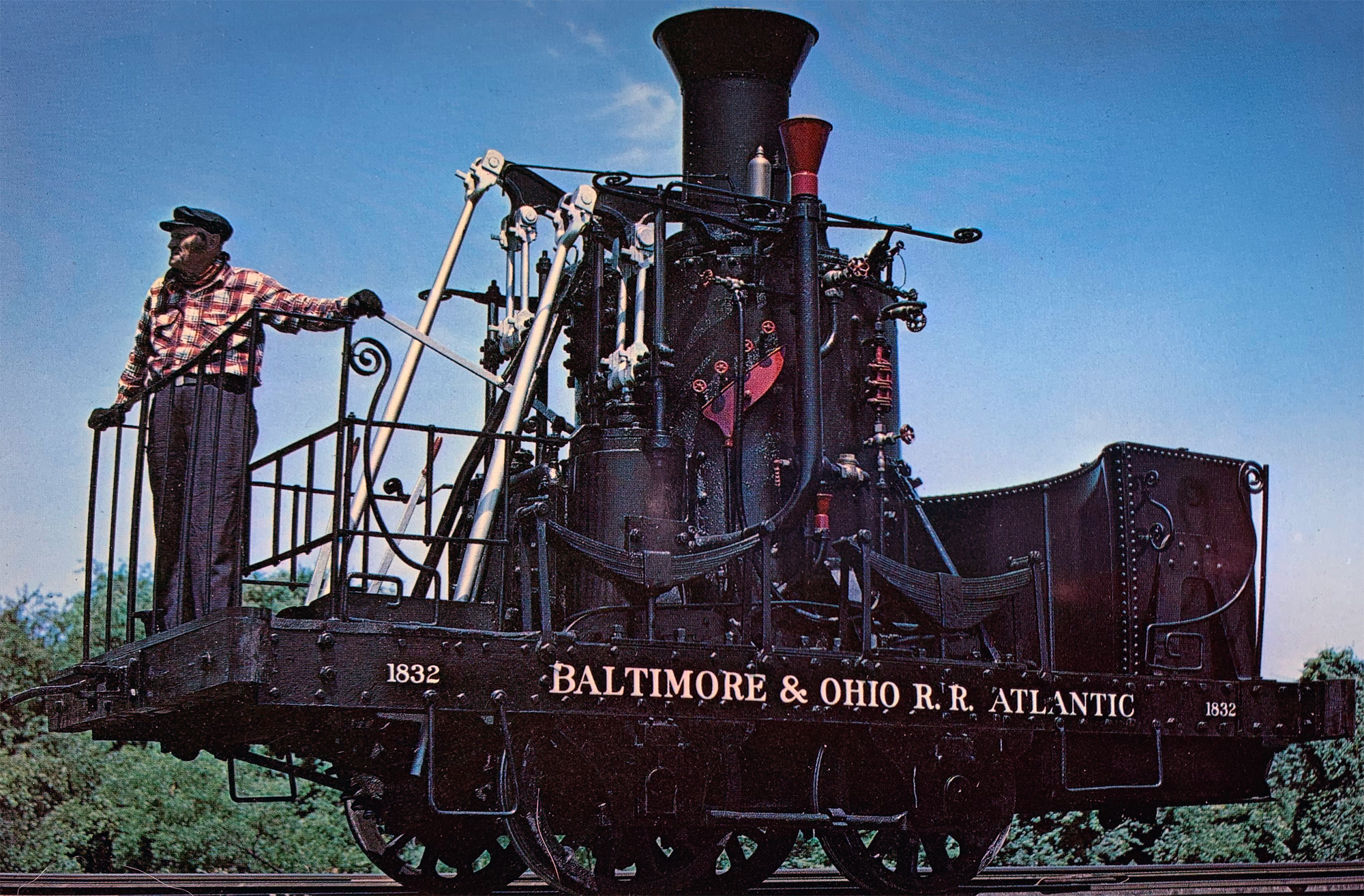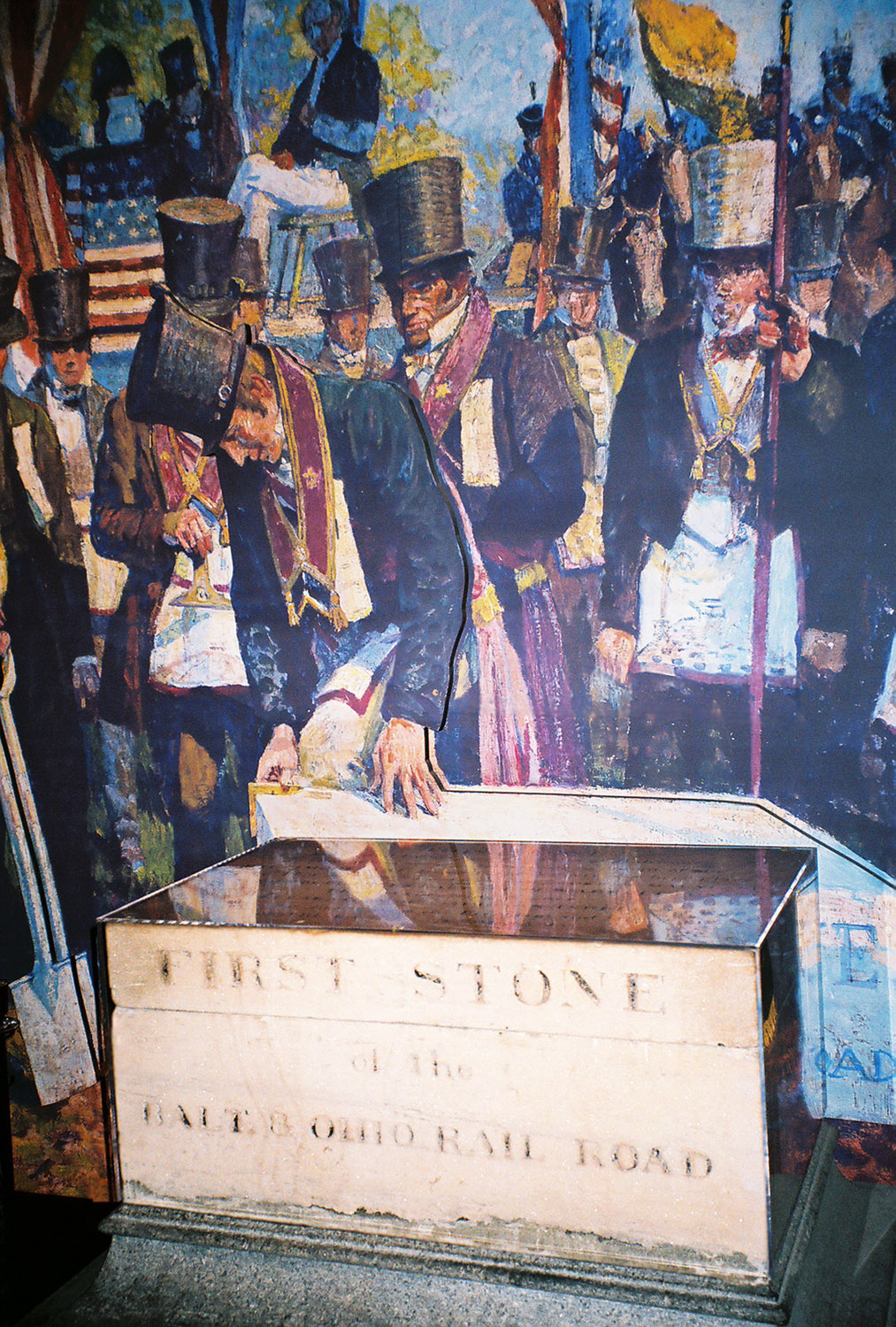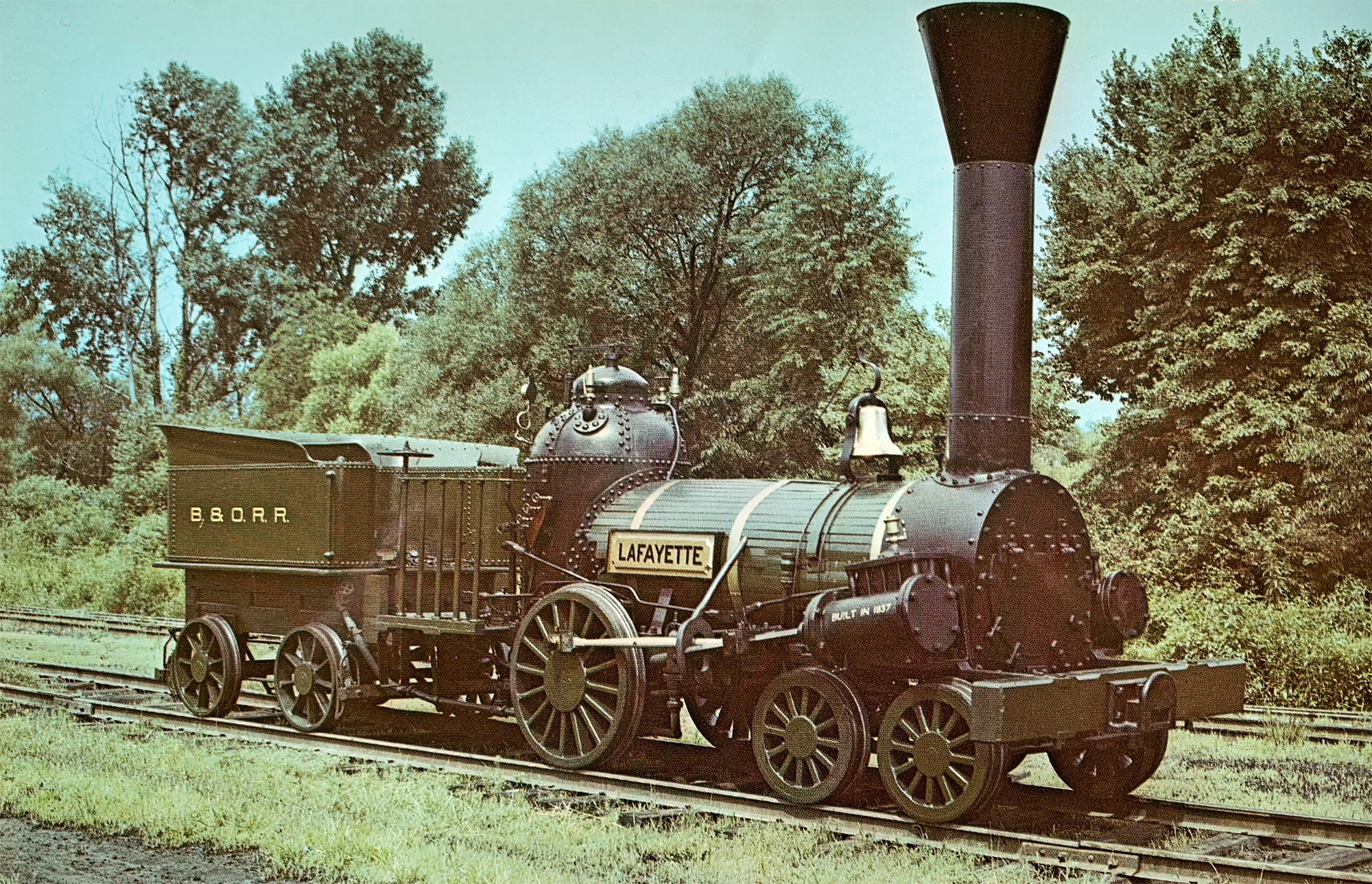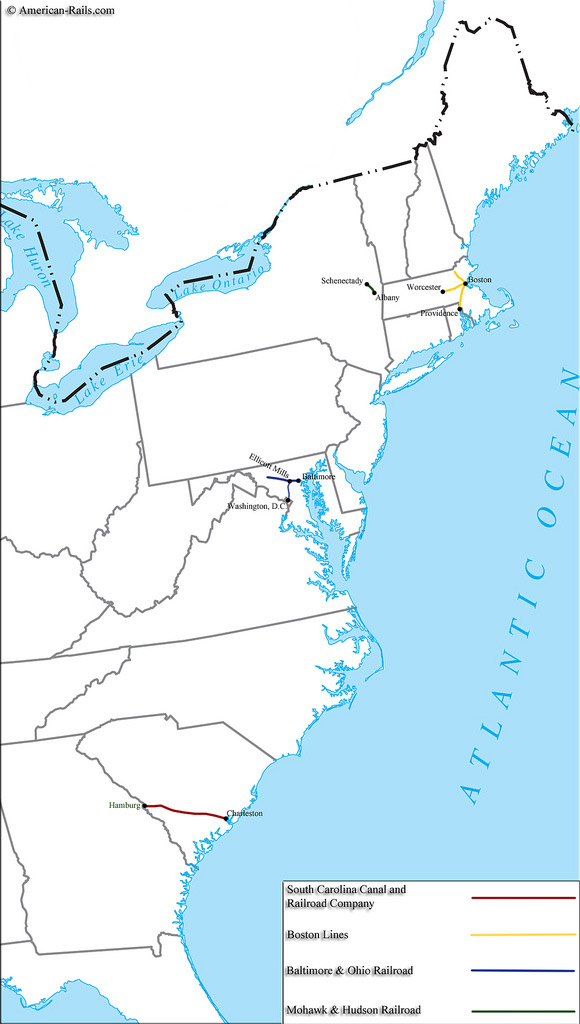Railroads In The 19th Century (USA)
Last revised: February 27, 2025
By: Adam Burns
As T.J. Stiles points out in his authoritative title, "The First Tycoon: The Epic Life Of Cornelius Vanderbilt," the railroad fundamentally changed the United States in far more ways than simply improved transportation.
It ushered in the modern, corporate America we know today where huge conglomerates preside over nearly every facet of our lives. The railroad was the first business of its kind to employ thousands, serve millions, and capitalized in the hundreds of millions.
They directly impacted numerous, intercity municipalities although, ironically, were privately owned ventures.
As the 19th century dawned no one could have imagined such incredible machines would soon exist to whisk freight and passengers at previously unheard-of speeds. But as with all technologies the railroad was slow to develop.
Timeline
After the steam-powered Stockton & Darlington Railway debuted in England during 1825 the first rudimentary, non-steam powered systems appeared in the United States the following year.
However, more than a decade would pass before railroading truly took hold in America. By 1840 railroads were here to stay although many technological developments remained before efficient, safe operations became commonplace.
Photos
 One of the first steam locomotives manufactured in the United States was the Baltimore & Ohio's 0-4-0 #2, the "Atlantic," completed in 1832 by Phineas Davis and Israel Gartner of York, Pennsylvania. The original "Atlantic" was scrapped in 1835 but its sister, the "Andrew Jackson" (#7), built by Davis and Gartner in February, 1836, still survives today at the Baltimore & Ohio Railroad Museum where it masquerades as the "Atlantic." Author's collection.
One of the first steam locomotives manufactured in the United States was the Baltimore & Ohio's 0-4-0 #2, the "Atlantic," completed in 1832 by Phineas Davis and Israel Gartner of York, Pennsylvania. The original "Atlantic" was scrapped in 1835 but its sister, the "Andrew Jackson" (#7), built by Davis and Gartner in February, 1836, still survives today at the Baltimore & Ohio Railroad Museum where it masquerades as the "Atlantic." Author's collection.1820s
As Mr. Stiles' book notes, early U.S. railroads were not conceived to provide interstate, or even intrastate, travel. Instead, they were constructed entirely for specific needs. Take, for instance, America's first, the Granite Railway of Massachusetts.
It opened on October 7, 1826 carrying a wide gauge of 5 feet. The line was only 3 miles in length and entirely horse or mule-powered. Its entire purpose was to transport granite slabs between Quincy and the Neponset River (Milton) for construction of the Bunker Hill Monument project.
In an era long predating the modern, all-steel "T" rail, the Granite Railway utilized massive stone rails. This was unique and rare even for that time period when many engineers were employing the cheaper, and lighter, strap-iron technique. During the late 1820's several projects were underway up and down the eastern seaboard.
One of the first was the Mohawk & Hudson Railroad, incorporated on April 17, 1826 to connect the Hudson River at Albany with the Mohawk River at Schenectady. It was designed as a shortcut to compete against the heralded Erie Canal for transporting people and goods between Schenectady and Albany (state capital).
1830s
Due to funding issues it took more than four years until construction began and was not completed until August 9, 1831.
On that day a little 0-4-0, named DeWitt Clinton, pulled the first load of paying customers, earning it recognition as the first steam locomotive to operate in New York.
The long delay in M&H's completion meant other operations were credited with various "firsts." Most notable was the Baltimore & Ohio.
The B&O was created largely out of a great need by the city of Baltimore to compete with the Erie Canal, which connected New York City with the Port of Albany at Buffalo. In addition, Philadelphia was organizing a plan to build a similar transportation system across the state linking Pittsburgh.
Fearing its city would be left at an economic disadvantage Baltimore leaders formed the B&O, originally chartered on February 28, 1827. In January, 1830 the B&O launched service over its first 1.5 miles from a small station in Baltimore at Pratt Street. That same summer (August 28th) the railroad successfully tested Peter Cooper's 2-2-0 "Tom Thumb."
It lost its famous race with a horse that day but nevertheless proved the steam locomotive's viability. Cooper's contraption is also credited as the first American-built design ever placed into use although, as a test-bed unit, was never actually operated in regular service.
Overview (1820s/1830s)
1,000 (1835) 2,808 (1840) |
|
* Fewer than 100 early stagecoach cars were manufactured in the United States according to John White, Jr.'s book "The American Railroad Passenger Car: Part 1."
Sources (For Above Table):
- White Jr., John H. American Railroad Passenger Car, The: Part 1. Baltimore: The John Hopkins University Press, 1985 edition.
- White Jr., John H. American Railroad Freight Car, The: From The Wood-Car Era To The Coming Of Steel. Baltimore: The John Hopkins University Press, 1993.
- Schafer, Mike and McBride, Mike. Freight Train Cars. Osceola: MBI Publishing, 1999.
- McCready, Albert L. and Sagle, Lawrence W. (American Heritage). Railroads In The Days Of Steam. Mahwah: Troll Associates, 1960.
Another important railroading pioneer was the Delaware & Hudson Canal Company. According to Jim Shaughnessy's book, "Delaware & Hudson: Bridge Line To New England And Canada," it was conceived by brothers Maurice and William Wurts to transport clean-burning anthracite coal from mines near Carbondale, Pennsylvania to New York City for home and commercial heating purposes.
Their original plans called for a duel, canal/gravity railroad. The latter was designed by John B. Jervis and the company ordered four steam locomotives from England to handle the necessary tonnage. Only one would ever be used, the Stourbridge Lion, manufactured by Foster, Rastrick & Company of Stourbridge, England.
Jervis tested the little 0-4-0 on August 8, 1829 but sadly it proved too heavy for the track. Despite this setback the little locomotive earned distinction as the first standard design ever operated in the United States.
The next significant development occurred on the South Carolina Canal & Rail Road Company, a system based in Charleston, South Carolina.
 Birth of an industry, the laying of the first stone by Charles Carroll on the Baltimore & Oho Railroad, our country's first common carrier, which took place on July 4, 1828. It is now displayed at the B&O Railroad Museum. Author's collection.
Birth of an industry, the laying of the first stone by Charles Carroll on the Baltimore & Oho Railroad, our country's first common carrier, which took place on July 4, 1828. It is now displayed at the B&O Railroad Museum. Author's collection.The SCC&RR was the longest railroad of its day when it opened 136 miles between Charleston and Hamburg (near Augusta, Georgia) during October, 1833. The project's purpose was, once again, to serve a specific need.
In this case, the port of Charleston wanted to haul agricultural products from inland farms, notably cotton, to the city for shipment. It was formed on December 19, 1827 and began construction thereafter.
Aside from its length and importance the SCC&RR also carries the honor as the first to operate an American-built steam locomotive in revenue service when the Best Friend Of Charleston (built by the West Point Foundry of Cold Spring, New York) carried a trainload of paying customers on December 25, 1830.
Another noteworthy railroad was New Jersey's Camden & Amboy, formed on February 4, 1830 as the Camden & Amboy Rail Road Transportation Company.
A project of Robert Stevens it was envisioned to link the Delaware River at Philadelphia with the Raritan River, which ran into New York City. Many railroads of this era were built specifically to complement either preexisting canals or highly trafficked waterways.
This was the case for the C&A which began construction in December, 1830 at Bordentown, New Jersey. The first 13 miles to Hightstown opened to the public on October 1, 1832. Its first steam locomotive, the 0-4-0 John Bull (built by the Robert Stephenson & Company of England) entered service in 1833.
The locomotive is significant due not only to its early design but also modifications which later became standard on future models; C&A personnel added a lead bogie (truck) to decrease derailments (giving it a 2-4-0 wheel arrangement), a pilot (cow-catcher) to move animals off the right-of-way, a covered cab for the crew's protection against the weather, headlight, bell, and even a covered tender.
By then it had become part of the much larger United Canal & Railroad Companies. (The C&A would later join the growing Pennsylvania Railroad [PRR[ in 1871.) Also of note was Philadelphia's Main Line, a combination canal and rail artery built during the 1830s to connect western Pennsylvania with the Ohio River.
Unfortunately it was much too cumbersome; the canal operation was eventually scrapped and the rail corridor turned over to the PRR. The early railroads dealt with much more than just engineering and logistical issues.
Not everyone was sold on the newfangled technology and canal owners lobbied heavily to suppress or outright deny their construction.
The public had justifiable safety concerns although in some cases the dangers were completely exaggerated. As John Stover points out in his book, "The Routledge Historical Atlas Of The American Railroads," some of the more ridiculous assertions claimed they were a "device of the devil" and could cause a "concussion of the brain."
Development
While England could proclaim itself as railroading's birthplace, by 1840 its total mileage (1,500) had been far surpassed by the United States. Interestingly, the financial Panic of 1837 did not seriously inhibit railroad construction, unlike later on when these economic recessions seriously stunted additional mileage.
As previously discussed, the B&O was a pioneer in nearly every facet. Its value in advancing new techniques, which later became standard practice, can also not be understated.
As by Kirk Reynolds and David Oroszi note in their book, "Baltimore & Ohio Railroad," nearly everything decision it made was an educated guess based on what little was known about railroads and engineering practices at the time.
Perhaps most challenging was constructing a proper right-of-way and figuring out the curvature limits and gradient a typical train could handle.
To aid in this endeavor its engineers sailed to England for ideas concerning these topics. Among their most notable takeaways was track gauge; English lines were utilizing a width of 4 feet, 8 1/2 inches which was ultimately adopted by the B&O.
 An engraving by H.W. Wanderwall depicting the early Pontchartrain Rail-Road (chartered 1830 and commenced service in 1831) which connected Elysian Fields Street in New Orleans to the shores of Lake Ponchartrain at Milneburg, a distance of 5 miles.
An engraving by H.W. Wanderwall depicting the early Pontchartrain Rail-Road (chartered 1830 and commenced service in 1831) which connected Elysian Fields Street in New Orleans to the shores of Lake Ponchartrain at Milneburg, a distance of 5 miles.Its next task was in designing a track guideway for the trains' wheels to follow. Once again, engineers found themselves in unknown territory as they experimented with various techniques from stone guideways with wooden beams to iron straps using the same principle.
They eventually learned the best, most economical design was a wooden beam reinforced with a iron strap supported by wooden crossties.
Iron strap rails did work although proved incredibly dangerous as worn straps could let go causing the deadly phenomenon of "snake heads," which easily ripped through the floors of early wooden cars and maimed or killed passengers.
Finally, engineers had to conceive a right-of-way capable of handling this new form of technology. Once more, with no books or prior research to guide them, Lieutenant Colonel Stephen H. Long of the U.S. Army who was overseeing survey work, and Johnathan Knight, a civil engineer simply made educated guesses.
The B&O would initially use horses to power their trains with the intentions of one day switching to steam propulsion. As a result, Knight and Long used very conservative figures, limiting the ruling grade to a very respectable 0.6% (or a mere 6 inches of elevation for every 100 feet traveled).
Interestingly, they allowed curves to be relatively sharp at 14-18 degrees, unaware the length trains would one day reach. Future practice would allow for stiffer grades with less severe curves.
Early Freight And Passenger Cars
Gaining a true understanding of early railroad car development can be difficult due to anecdotal stories or just outright misinformation. It is further complicated by the lack of historical documents available.
If you are interested in this subject three books on the topic are a must, all written by John H. White, Jr.: "The American Railroad Passenger Car" (Parts I and II) and "The American Railroad Freight Car." As he notes, the story of America's first passenger cars built from stagecoaches remains widely told to this day.
In reality, while these were influenced from stagecoaches and manufactured by stagecoach builders, they were actually designed from the chassis up.
The first known passenger car contract was awarded to Richard Imlay of Baltimore in 1828 when the Baltimore & Ohio approached him about supplying the company with equipment.
The first, based from the standard mail coach of the day, was named the Pioneer and placed into service during May, 1830. It was followed by five more nearly identical designs that same August.
Information on freight cars from this period is even more scarce since the public paid little attention to such things and there were no agencies in place to monitor railroads.
 In this Baltimore & Ohio publicity photo, probably from the 1960's, the replica 4-2-0 "Lafayette" is featured. The locomotive was originally built by William Norris of Philadelphia in 1837. The original was scrapped in 1863 but a replica was completed in 1893. This particular locomotive was the B&O's first to feature a horizontal boiler supported by three axles. It was also the B&O's first to boast horizontal cylinders and connecting rods between the pistons and drivers. Author's collection.
In this Baltimore & Ohio publicity photo, probably from the 1960's, the replica 4-2-0 "Lafayette" is featured. The locomotive was originally built by William Norris of Philadelphia in 1837. The original was scrapped in 1863 but a replica was completed in 1893. This particular locomotive was the B&O's first to feature a horizontal boiler supported by three axles. It was also the B&O's first to boast horizontal cylinders and connecting rods between the pistons and drivers. Author's collection.Impact
The previously mentioned Granite Railway employed a basic, reinforced wooden flatcar designed by Gridley Bryant which utilized horse power to transport the marble over huge stone rails. Again, during an era without reliable references ideas and concepts were abundant.
According to Mr. White's book:
"The first series of cars were carried by four wagon wheels. The stones were carried below the axles on a platform raised or lowered by a hand-powered winch fastened to a wooden truss frame that stood above the wheels." For such an early period these cars were well crafted, finely built contraptions.
Bryant's concept proved so successful that it remained unchanged until the original Granite Railway system was abandoned in 1866.
In 1830, and throughout that decade, most freight was transported in either a flatcar, a simple gondola (A simple flatcar with short sides to hold ladding [freight], it is more commonly known as the gondola.
The first is credited to the Baltimore & Ohio of 1832 which referred to it as a "flour car" since it handled barrels of flour.), or an early type of hopper known as a "jimmie." The latter predominantly handled anthracite coal, such as the small, 1,600-pound cars found on the Lehigh Coal & Navigation Company at Mauch Chunk, Pennsylvania.
These small cars could handle about 3,000 pounds each and transported anthracite coal from open-pit mines near Mauch Chunk over a 9-mile, 42-inch gauge railroad to the Lehigh River where the product was carried on to eastern points such as Philadelphia.
As the 1840's dawned, railroads were becoming a unified network but much work remained at established a system capable of efficient, interstate service.

